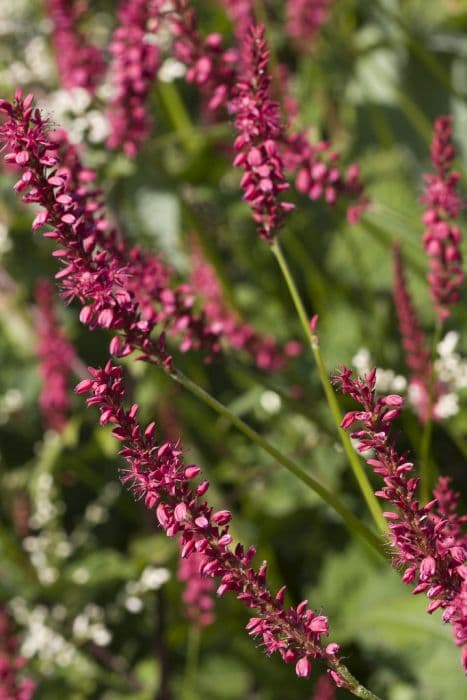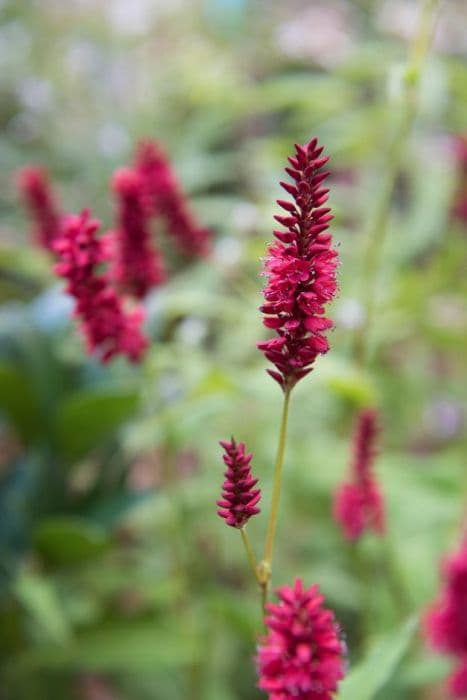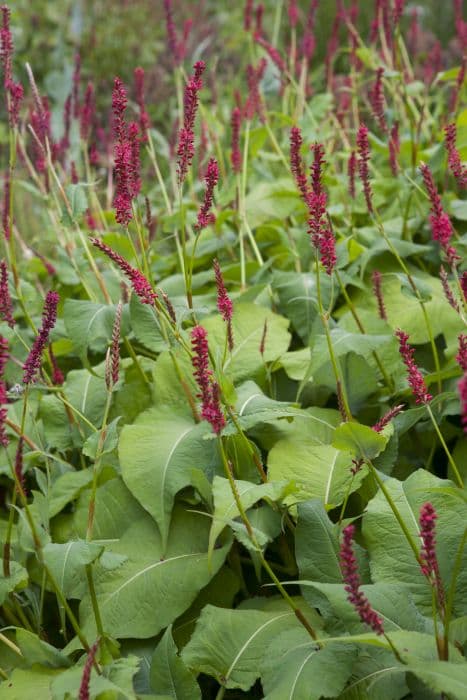Knotweed Persicaria milletii

ABOUT
Persicaria milletii, more commonly referred to as "smartweed" or "knotweed," is a plant with distinctive features that identify it amongst the flora. The plant is characterized by its elongated, lance-shaped leaves that come to a pointed tip. The leaves are often green, sometimes with a reddish or purplish hue, especially along the midrib and the edges, giving them a variegated appearance. Throughout the growing season, smartweed produces small, dense clusters of flowers. These flowers can vary in color, commonly pink or white, and are arranged on slender flower spikes. The plant's stems are typically reddish-brown and can be spotted with flecks of color that match the leaves and flowers, adding to the overall vibrancy of the plant. Depending on the variety, the stems may be upright or sprawling. Smartweed's roots are fibrous, anchoring it to moist soils where it often thrives. The overall appearance of smartweed is that of a robust and adaptable plant, suited to a range of environments, with an aesthetic that can add both color and texture to the landscapes it inhabits.
About this plant
 Names
NamesFamily
Polygonaceae
Synonyms
Millet Knotweed, Millet Smartweed
Common names
Polygonum milletii, Persicaria chinensis, Polygonum chinense
 Toxicity
ToxicityTo humans
Persicaria milletii, commonly known as knotweed, is not widely recognized as a highly toxic plant to humans. However, due to the vast array of plant species and the possibility of individual allergic reactions or varying sensitivity levels, mild gastrointestinal upset could occur if ingested. Symptoms of plant poisoning can differ greatly but often include nausea, vomiting, diarrhea, and stomach pain. In some cases, a rash may develop if there is skin contact in individuals who have a sensitivity to the plant. Always exercise caution and consult with a healthcare professional or a poison control center if ingestion occurs.
To pets
Persicaria milletii, known as knotweed, is not typically listed as a major toxic plant to pets like cats and dogs. Nevertheless, pets may experience negative reactions to ingesting plants that are not part of their usual diet. Consumption of knotweed could potentially cause mild gastrointestinal upset in some pets, with symptoms such as vomiting or diarrhea. If a pet ingests this plant and exhibits signs of distress, contacting a veterinarian for guidance is recommended. It's important for pet owners to monitor their pets and prevent them from eating plants that are not meant for consumption.
 Characteristics
CharacteristicsLife cycle
Perennials
Foliage type
Deciduous
Color of leaves
Green
Flower color
White
Height
3 feet (0.91 meters)
Spread
2 feet (0.61 meters)
Plant type
Herb
Hardiness zones
Varies
Native area
China
Benefits
 General Benefits
General Benefits- Erosion control - Persicaria milletii helps in stabilizing soil and preventing erosion with its extensive root system.
- Wildlife habitat - It offers shelter and food for various species of wildlife, including birds and insects.
- Ornamental use - Persicaria milletii adds aesthetic value to gardens with its vibrant foliage and flowers.
- Pollinator attraction - The flowers attract bees and other pollinators, supporting local ecosystems.
- Ground cover - It can provide an effective ground cover, reducing weed growth and maintenance efforts.
 Medical Properties
Medical Properties- Anti-inflammatory: Persicaria milletii may possess compounds that help reduce inflammation.
- Antioxidant: The plant could contain antioxidants that scavenge free radicals and offer protection against oxidative stress.
- Hepatoprotective: There might be elements within Persicaria milletii that protect the liver from damage.
- Antimicrobial: Compounds in the plant may act against certain bacteria or fungi, preventing or slowing their growth.
 Air-purifying Qualities
Air-purifying QualitiesThis plant is not specifically known for air purifying qualities.
 Other Uses
Other Uses- Persicaria milletii, widely recognized as "knotweed," can be used in the production of natural dyes for fabrics, providing a range of earthy tones depending on the mordant used.
- The fibers from knotweed stems can be harvested and processed to make paper, offering an eco-friendly alternative to traditional wood pulp paper.
- Knotweed is sometimes used in garden landscaping to provide fast-growing ground cover that can help prevent soil erosion.
- The abundant flowers of knotweed attract pollinators such as bees and butterflies, enhancing the health and diversity of gardens and wild areas.
- In regions where knotweed is deemed invasive, it can be utilized in controlled biomass production for biofuel, making use of its robust growth habits.
- Knotweed can be incorporated into floral arrangements, both fresh and dried, due to its profusion of small, attractive flowers.
- Some cultures use knotweed as a green manure or composting ingredient, taking advantage of its nutrient-rich foliage to improve soil quality.
- The vivid fall foliage of knotweed can add seasonal color to gardens, as the leaves often turn bright shades of red and orange.
- Knotweed stems, being hollow, can be used in crafting and DIY projects, such as making plant stakes or for constructing lightweight structures.
- In culinary arts, young shoots and leaves of certain varieties of knotweed may be consumed as a cooked green vegetable, similar to how spinach is used.
Interesting Facts
 Feng Shui
Feng ShuiThe plant Persicaria milletii, commonly known as kiss-me-over-the-garden-gate, is not used in Feng Shui practice.
 Zodiac Sign Compitability
Zodiac Sign CompitabilityKiss-me-over-the-garden-gate is not used in astrology practice.
 Plant Symbolism
Plant Symbolism- Adaptability: Persicaria milletii is known for its ability to thrive in various soil types and conditions, symbolizing flexibility and the ability to adjust to different situations in life.
- Resilience: This plant's hardy nature reflects resilience and the capacity to overcome adversity, as it can grow vigorously despite challenging environments.
- Connection: The spreading habit of Persicaria milletii, with its extensive root system, represents the idea of interconnectedness and building strong networks and relationships.
- Growth: The fast growth rate of this plant symbolizes personal growth and development, encouraging individuals to embrace change and progress.
- Prosperity: In some cultures, vibrant, green plants like Persicaria milletii are associated with abundance and prosperity, signifying a flourishing life or business.
 Water
WaterThe Kiss-me-over-the-garden-gate plant should be watered thoroughly, ensuring the soil is evenly moist but not waterlogged. During the growing season, this typically means watering approximately once a week, with about 1.5 gallons for an outdoor garden plant, depending on climate conditions such as heat and wind, which may accelerate evaporation. When rainfall is scarce, pay extra attention to watering needs. In cooler months or when the plant is not actively growing, reduce watering frequency. Always check the top inch of the soil before watering; if it's dry, it's time to water.
 Light
LightFor optimal growth, Kiss-me-over-the-garden-gate should be placed in a location that receives full sun to partial shade. The best spot for the plant is one where it gets at least 6 hours of direct sunlight per day, although it can tolerate light shade, especially in hot climates. Avoid deep shade as it will affect the plant's vigor and flowering potential.
 Temperature
TemperatureKiss-me-over-the-garden-gate thrives in a temperature range between 60°F and 75°F, which is typically regarded as ideal growing conditions. It can survive in temperatures as low as 50°F and as high as 90°F. To promote healthy growth, try to maintain the temperature within this range and protect the plant from extreme temperature fluctuations.
 Pruning
PruningPrune Kiss-me-over-the-garden-gate to remove spent flowers and encourage bushier growth. Pruning can be done as needed throughout the growing season to maintain the desired shape and size. The best time for a more thorough pruning is in late winter or early spring before new growth begins, which helps invigorate the plant for the coming season.
 Cleaning
CleaningAs needed
 Soil
SoilPersicaria milletii, commonly known as kiss-me-over-the-garden-gate, thrives in fertile, moist but well-drained soil. A good soil mix for this plant would include garden soil, compost, and a bit of sand to improve drainage. The ideal soil pH should be slightly acidic to neutral, ranging from 6.0 to 7.0.
 Repotting
RepottingKiss-me-over-the-garden-gate typically doesn't require frequent repotting. It should be repotted every 2-3 years or if it becomes root-bound. Spring is the best time to repot this plant to minimize stress and encourage growth in the growing season.
 Humidity & Misting
Humidity & MistingKiss-me-over-the-garden-gate prefers a moderately humid environment. Indoor specimens benefit from a humidity level of about 40-50%. If the ambient humidity is too low, a pebble tray or humidifier can help maintain adequate moisture levels.
 Suitable locations
Suitable locationsIndoor
Grow indoors in rich soil, high humidity, and indirect sunlight.
Outdoor
Plant in moist, well-drained soil with partial to full sun exposure.
Hardiness zone
4-8 USDA
 Life cycle
Life cyclePersicaria milletii, commonly known as Jointweed, begins its life as a seed, which germinates in favorable conditions of moisture and temperature, often in the spring. After germination, the seedling emerges, developing roots and a shoot that reaches toward the light. As it grows, it forms a rosette of leaves and then elongates its stem to produce mature leaves and starts to branch. The vegetative growth phase is followed by the flowering stage, where the plant produces small, inconspicuous flowers that are typically white or pink. Following pollination, these flowers develop into fruits containing seeds. The plant completes its life cycle when these seeds are dispersed into the environment, which can occur through various mechanisms such as wind, water, or animal movement, allowing for the establishment of new Jointweed plants.
 Propogation
PropogationPropogation time
Spring-summer
Propogation: Persicaria milletii, commonly known as knotweed, is typically propagated through division, which is a popular method for many perennial plants. The best time to propagate the plant is in the spring when the plant begins to show new growth. To propagate by division, take a mature knotweed and carefully dig around the plant to lift it from the soil while trying to minimize root damage. Once the plant is out, use a sharp spade or knife to divide the root clump into smaller sections, each with several shoots and a portion of the root system. These sections can then be immediately replanted in well-prepared soil, spaced about 12 inches (approximately 30 centimeters) apart to allow room for growth. Water the new plants thoroughly after planting to help establish them. This method allows for quick multiplication of plants while preserving the characteristics of the parent plant.









